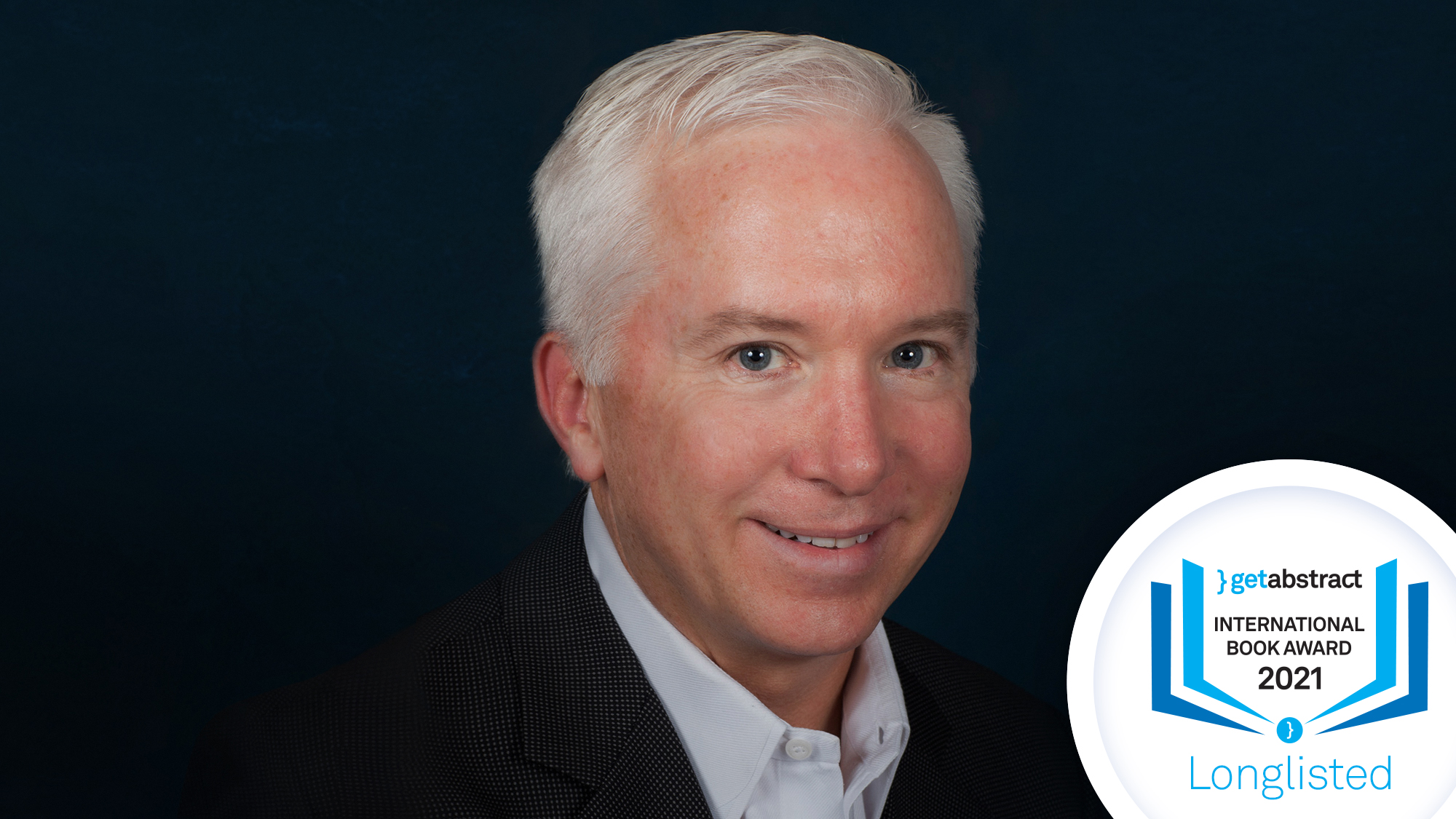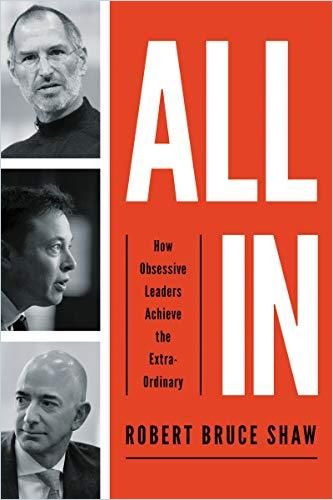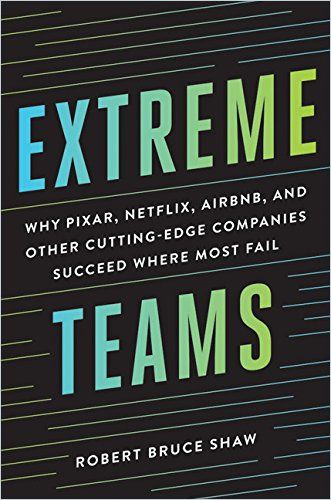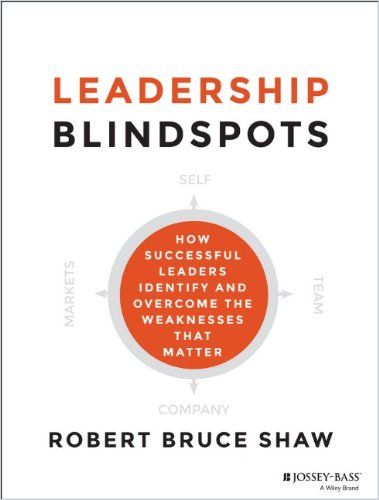“Good Requires Motivation, Great Requires Obsession.”

Robert, in your book All In, you write about disruptive, iconoclastic leaders such as Jeff Bezos, Elon Musk and Travis Kalanick who are obsessive. How are obsessive leaders different from more typical corporate leaders?
One of the themes in the book is that obsession in itself isn’t productive if not focused on the right areas. Jeff Bezos and Elon Musk are noteworthy in being obsessed with what truly matters. With Bezos, he focused on customers. His goal was to create the most customer-centric company in the world. If you look Amazon’s actions over the years, time and again, it has done things that benefit customers. For example, when they first started providing book reviews, people told them they shouldn’t do that unless they skew them to the positive. Bezos said no, the customer wants to know the positive and the negative. That will help them make better choices and more likely to use Amazon in the future. That’s what he did.
How about Musk?
In the case of Elon Musk, he is focused on designing and building extraordinary products. I mean, think of EVs (electric vehicles). When he came into the industry, there was no demand for them per se, and the cars were inferior. He’s created a car, against all odds, that’s superior to any conventional internal combustion car. So, his obsession is creating revolutionary products that are superior to what is now in the market. Bezos and Musk are different in the singular focus they bring to the work and their relentless drive to achieve their vision.
But you say this obsession is beyond “grit.”
Yes, it’s much more than grit. Leaders such as Musk are far more than gritty in terms of their intensity and the way they go about their work. An example is Musk when Tesla was having problems with the Model 3 production. He went in and lived at the plant for weeks on end, didn’t go home, stayed there and worked through the problems. Not many corporate leaders would do that. They would assign a team or an individual to address the problem. But Musk went in himself, worked with his team and fixed the problems that were threatening the company’s very survival. So, it’s a level of “all in” intensity that goes far beyond what you find in most corporate leaders.

How necessary to success is this level of obsession?
Do you need obsession in every organization? In many cases you don’t. If you’re in a traditional industry with few challenges, you don’t need leaders who are completely consumed with their work. But if you’re trying to challenge the status quo and create something transformative, you do. In these cases, these types of leaders are absolutely necessary, and companies need to attract and manage them effectively. A theme of the book is that good requires motivation, great requires obsession. The other point to emphasize is that obsession, in itself, is necessary but insufficient. You also need an exceptional level of talent and some luck to create a company like Amazon or Tesla.
This brings to mind something I read about hiring digital talent and how great it would be for companies to have their own Steve Jobs. So, would it? He had genius, but also a notoriously difficult personality.
Well, you have to look at your industry and what you’re trying to achieve and then calibrate what level of obsession is required. If you’re Amazon trying to upend the retail industry through e-commerce, or if you’re Musk trying to create viable EVs – you need these types of leaders. You don’t need every person to be this way, but you need a significant number of people who are fully committed to making an extraordinary product or service. I’m not saying that every company necessarily wants everyone to be at this level, but you need a significant number at each level, not just at the senior level.
One of the lines that Musk uses when speaking of Space X is, ‘You don’t go to Mars working 40 hours a week.’ You need a level of commitment and passion that’s going to create that level of achievement.
Robert Bruce Shaw
What’s interesting to me is that a lot of the emphasis now is on work-life balance and creating psychologically safe environments with lower stress levels. But the companies I profile aren’t low-stress environments, these are high-stress environments often populated by demanding and at times difficult people. The question is, how do you create companies that can manage that and not back away from it?
What are some of the downsides to being so obsessive?
Well, there are several. One is burnout. Either the leader burns out or he or she burns out the team. Or they create a culture that’s too harsh because the demands are too intense. One of the quotes I give in the book is from somebody who worked for Steve Jobs in developing the Macintosh: He said it was the most gratifying experience of his life, but he sacrificed everything for it, including his marriage, time with his children and his health. So, if you’re not careful, the passion that drives these achievements can also create great harm to the individual, his or her family and co-workers.
Are there other risks that come with obsession?
You need to have safeguards in place that delineate what should and shouldn’t happen. Sometimes driven leaders are ethically challenged. They can do things that are tone-deaf, unethical or even illegal – creating problems not only for themselves but for their companies and customers. I talk about Travis Kalanick in my book and he’s probably the best example of the risks of being obsessive. So, you have to put some boundaries in place that protect you from behavior that is “out of bounds.”
Can you give an example of a way that Kalanick pushed too far? Sort of the good and the bad of his leadership?
One example is he was developing autonomous driving capabilities. Uber put cars on the road in San Francisco that weren’t licensed to drive autonomously. Uber claimed that they had a driver in the car and were thus operating legally, but there were indications that these cars were running stoplights and putting the public in danger. So, again, back to the obsession: They wanted to be successful with autonomous cars but at the same time they were ignoring, if not violating local regulations. That’s one of many examples of Uber operating in the past that was, in part, destructive. In my book, there’s a chapter on Kalanick and some of the missteps he took not only in terms of regulators, but how his firm at times mistreated customers and, in some cases, employees. So, you run the risk at these cultures that they spin out of control and are driven to achieve their goals at almost any cost.
Well, I would like to know what the organizations can do to avoid this risk, but first, let’s talk about teams a little bit and culture. You wrote a book called Extreme Teams which explored culture at cutting edge companies and how obsession plays into that, how a company like Netflix, for instance, encourages obsession. How much of their success is due to the obsessions at the top and how much is due to sort of baking in obsession throughout the culture, or is it more like supportive teamwork and processes? I’m just curious about where the line is between processes that will generate creativity and obsessiveness – I guess they feed into each other.
When I wrote Extreme Teams I profiled seven teams. One of the things most striking to me was all of them were founded by driven, charismatic leaders. They had very clear views of what they wanted to achieve. And then how did they scale that obsession? How did they create an organization that could enact their beliefs in a way that would be productive and successful over time? Teams are one way that happens. So, productive obsession starts with the leader. It doesn’t have to be a founder necessarily, but very often it is.
In many great companies, the personalities of the founders come to permeate the culture, their values and beliefs and even style. I describe this as scaling their obsession.
Robert Bruce Shaw
An inventor has great ideas but often can’t create something commercially viable. By contrast, an entrepreneur brings a great idea to market. A critical part of the way they do that is by creating focused and driven teams. They find people equally passionate, either, in the case of Amazon, about being customer-centric, or like Musk in terms of building extraordinary products. You populate your company with such people and then build team structures that can function in a productively obsessive way. It starts with the leader and is scaled through teams. So that’s the way I think about the relationship between these obsessive leaders and the teams that work within the organizations.

Okay. I’m interested: What do productively obsessive teams look like? And I’d also like to ask you: How do you create conflict-friendly processes that obsessive leaders will listen to?
One of the things I’m often asked is: Are these leaders arrogant to the point they won’t listen to others? And there is a certain degree of narcissism that comes with this level of drive because you passionately believe that what you envision can become a reality. So, if you’re Elon Musk, working against all odds, you get people saying repeatedly you can’t go to Mars. Or that it is impossible to build reusable rockets. Then here comes Musk, with no background in the aerospace industry, and he does it.
These people have to have a tremendous amount of confidence. People don’t realize that visionaries have legions of critics, people telling them they will fail.
Robert Bruce Shaw
Take Amazon, for example. There was a famous analyst who said that once Barnes and Noble went online with book retailing, they should call his firm Amazon.toast rather than Amazon.com, because it would soon be destroyed by a much larger competitor. So, there’s a certain element of hubris required to withstand the critics and setbacks. But what I find with these leaders is that they’re so passionate about their products and services that they will listen to others if an argument is well made. If not, they can be very tough on their people.
Like?
Let me give you an example. Bezos had a meeting with his senior team including the head of the customer service group. Bezos asks him, how long does it take to answer the phone when people call? He provides the number which is but a few seconds. Bezos tells him, that isn’t what I hear. I think it takes a lot longer than that. So, Bezos gets the speakerphone out, calls customer service at Amazon with a team sitting there. He just waits. Five seconds go by, 10 seconds go by, 15 seconds go by, and the phone isn’t answered. He says thank you when the representative does answer, hangs up and then aggressively challenges the accuracy of the data that the customer service leader provided.
These are not easy places to work. But that doesn’t mean obsessive leaders don’t listen. That means that you better be prepared and have your data and your recommendations in order. Otherwise, they’re going to be very tough on you.
Robert Bruce Shaw
An interviewer said to Musk, “You don’t tolerate those who make foolish statements.” He replied, “Should I? I mean, do you build a great company like that?” So, part of it is you need people who can thrive in these tough environments. Not everyone wants this. But once you have those people on your team, they’re typically very loyal.
Right, it makes sense. I mean, after all, they are going to space. It is quite an achievement.
Or just consider what he has done on the EV front. I don’t think people appreciate how much Musk has created the industry, but if you look at what General Motors is doing now, what Volkswagen is doing, they’re all trying to catch up to him. And they may eventually get there. But do you think they would have changed without Musk? They would have continued to build conventional cars that pollute the environment. So, I have tremendous respect for leaders like Musk because while they sometimes do things that are inappropriate and they can be harsh on others, what they create benefits society, to my mind.
Certainly. I agree, these are truly amazing accomplishments. Can we talk a little more about the characteristics of a productively obsessive team?
As I mentioned earlier, the first thing is you need people who are fully committed to the mission of the company and passionate about it, because if you have people who are less than committed, it creates all kinds of problems within the team. You also need highly capable people. One of the things you find about obsessive people is they are so driven that they can look at other people as a means to an end. So, if you can’t contribute, they don’t have a lot of respect for you. That creates, again, problems for the team, if some members are not adding value. So, you need highly committed, highly capable people for the company and then you need an environment within the team that’s what I call “hard and soft.”
How does the “hard and soft” work?
So “hard” is very clear goals, metrics and processes in place. At the same time, there’s also a community feel, which sounds contradictory. But if you look at a company like Whole Foods, which has a team-based culture, there are a myriad of performance metrics along with a strong sense of community – a spirit of ‘we’re in this together.’ These teams bond, and some spend more time together than with their families. So, you have to create enough of a sense of community that’s not just going into work and achieving a task. There’s a human connection that has to be established.
The best companies and the best leaders that I’ve found create this ‘hard and soft’ combination, which is difficult to do, I’m not minimizing that, but they can do it in a way that they have highly committed, capable people working collectively towards a common goal.
Robert Bruce Shaw
In one scene I describe in the book, SpaceX launched the Falcon rocket after three failed launches. You look at the scenes of the team responsible for that, it’s just amazing because they’re ecstatic. They’ve gone through hell to make this happen. And they’re a month away from bankruptcy, by most accounts, and then they’re successful. And so, there is a sense of passion and collective achievement that you just don’t find on most corporate teams.
Sort of like the kind of the bonding that comes from war veterans, people working under intense pressure together.
I ended Extreme Teams with a story about my lifelong friend whose father was in World War II. He flew on bombing runs in Europe. I knew him towards the end of his life, in his early 90s. I went to visit him. He had a photograph of the crew that he flew with as an 18-year-old during the war. He was the last surviving member of that crew and I asked him about the photograph. He said that every day he looks at it and says the name of each crew member. I’m not saying that war is equivalent to being on a corporate team, but on the teams I describe it is a very deep bond that many don’t understand.
Well, it’s that functioning in a pressure cooker. It’s not literally life and death, but it is as close to life and death as you get in the corporate world, I would think.
Jobs told the story that when he introduced the Macintosh, the auditorium was full of ecstatic people. It was a revolutionary product at the time. After his presentation, he looked at those in the front row, members of his development team, and every one of them was crying. You might say, cynically, because they were just worn out. But really, they were crying because they had created, against long odds, something that was exceptional. I mean, you don’t get many opportunities in life to do that. The problem is, back to our earlier discussion, you pay a price for that level of achievement. People who think that comes without sacrifices are deluding themselves. Musk, for example, said that most people wouldn’t want his life if they lived it for a week. They like the fame and money. But if they lived his life, they would say this is too much. The constant stress, the 100-hour work weeks, the problems that others can’t solve, the vocal critics.
Sure, living where he works? And I know he’s had a few marriages, so obviously he’s paying a price. All these leaders in particular seem very, very unique. So, I guess that sort of leads to the next question, which is, what can individuals do to sort of cultivate the obsessions within themselves? But also, with a quick reference to your other book about Leadership Blindspots, how do such leaders recognize their blind spots and work around them?
I believe that obsession can be nurtured but not necessarily created, meaning that you can’t train somebody to be obsessive. And why some people are obsessive, I think, is a mystery. Why is Jeff Bezos the creator of Amazon and not his brother? They grew up in the same environment, had the same parents and grandparents. So, there’s a mysterious element to obsession that I think is pretty interesting. Companies that want this need to look for people that have it for whatever reason. If you have it, you have it and it is hard to fake over the long-term.

One of the things that Musk does when he interviews people is to ask them what significant problems they solved in their previous jobs. They may give him some generalities, but then he wants to go into the details because if they truly did it, they know all the details, right? He can tell you anything about his SpaceX rockets that you want to know because he dives deep into the specifics of every element of how they are designed and operate. So, it’s, again, finding people with that level of commitment and not everybody has that. One analogy I used in the book is everybody wants to be a loving individual, but some people are just, for whatever reason, more capable of loving others. Why? I’m not sure, but I don’t think everybody’s equal on that front. Same thing with obsession.
Not everybody has either the capability or the interest – or they’re not willing to pay the price that inevitably comes with obsession.
Robert Bruce Shaw
So, you can identify what might be your obsession but some might say, I don’t want work to consume my life. That’s okay. But then you don’t want to be in a company like Tesla because then you’re going to be miserable and you’re not going to be successful. So, some of it is knowing yourself and what you want. And then once the company has people that share its obsession, the question is how do they nurture it? One of the things I found is sometimes companies take advantage of obsessive people because they know that they’ll put in the extra time, they know that they’ll work harder and they do it in part not just for the extrinsic rewards, but more for the intrinsic rewards. There’s a fascinating study that looked at zookeepers and why they’re passionate about their work. The researcher found that the most committed zookeepers are, at times, taken advantage of by their organizations. So, obsessive people have to be aware that their companies can do this at times. And I’m not saying it’s done in a malevolent way, but it’s a reality that the people who love their work are often those who are given the work.
And guarding against blind spots?
Highly driven people often have blind spots and one of the most important things they need are people who are willing to challenge them when needed. And that’s where Kalanick, I think, failed in some respects. He was strong-willed and surrounded himself with people who were like him. Part of that was good in the sense that they were equally committed and aligned. But the problem was nobody could back him off from actions that hurt the company and himself. By the time he finally came around and realized he needed to change, it was too late. He had acted in a way that made it impossible for him to regain the trust of the people whose trust he needed to lead the company.
And his actions were a big problem for the brand, right? For Uber?
Absolutely. He was the face of the brand in many ways; he personified it. So, you get to the point where he was tarnishing the company’s reputation and investors worried that their financial gains were going to be eroded, that the brand was going to be damaged, and he became a liability. It’s somewhat sad because he’s a very intelligent, driven guy and Uber wouldn’t have been what it is without him. In many ways, he was responsible for Uber’s phenomenal growth. So, to me, that’s the classic case of obsession gone too far. I believe he made a mistake in being primarily focused on growing Uber and beating the competition, versus really being committed to either customers or products the way that Bezos and Musk are. So, you have to be careful. If the obsession becomes just winning, then I think a leader runs the risk of some of these mistakes.
Kalanick didn’t seem able to course correct.
If you look at the Uber experience, Kalanick would regularly apologize and say the firm was learning from its mistakes and evolving positively. But it continued to act in a self-destructive manner. Obsessives are always at risk of going down that path. Kalanick is a wonderful example of an exceptionally talented individual who lost his way or maybe never found it. Some described him as a pit bull, looking to fight anyone who stood in his way, who never matured as Uber grew into an increasingly important and visible company. Some leaders are so successful that board members are reluctant to get involved, even if they have the power, to pull back those who are driving this level of growth. My point is these leaders, and those who can influence them, need to be careful that their strengths don’t become weaknesses.
It seems in the company’s interest for the board to step in in some of these cases.
I mention in the book that, as the founder of Uber, the person with the ability to influence Kalanick was Garrett Camp. He was working behind the scenes, and we don’t know what he was trying to do with Kalanick – but whatever he did wasn’t effective. Kalanick imploded, which was unfortunate for him and his firm.
Right.
So, it’s an interesting dynamic in terms of how you deal with it. Most private equity firms want to be seen as founder-friendly in order to attract those who can create enormous wealth through their products and services. If you get a reputation of reining in founders, it’s harder to attract start-up companies. Boards are also reluctant to remove a visionary leader, particularly those with a history of success. What if the board gets it wrong and removes the person driving a firm’s growth? Consider what happened with Steve Jobs. The Apple board basically demoted him in what was a power struggle with then CEO John Sculley. Jobs soon resigned, but in essence, the firm’s board forced his hand – and that has to be one of the worst board decisions ever made.
About the Author
Robert Bruce Shaw is a management consultant specializing in organizational and leadership effectiveness. His work focuses on the development and implementation of new organizational strategies, structures and practices aimed at increasing long-term profitability and growth. In addition to All In: How Obsessive Leaders Achieve the Extraordinary, he is also the author of Extreme Teams: Why Pixar, Netflix, Airbnb, and Other Cutting-Edge Companies Succeed Where Most Fail and Leadership Blindspots: How Successful Leaders Identify and Overcome the Weaknesses That Matter, among other titles.










